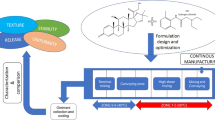Abstract
The use of hot-melt extrusion (HME) technique in the preparation of semi-solid products offers several advantages over conventional processes. However, the optimization of the technique for preparation of semi-solid pharmaceuticals is challenging due to involvement of ingredients with different physical properties. Hence, a simple tool to optimize the mixing of ingredients that results in a target ratio and drug content uniformity is utmost important. In this study, a handheld colorimeter has been explored to optimize the process variables of twin screw processor for preparation of hydrophilic PEG-based ointment. The process parameters which were optimized with use of handheld colorimeter have been used for preparation of polyethylene glycol–based metronidazole ointment. The metronidazole ointment prepared by twin screw processor was compared with commercially available metronidazole gel for in vitro release testing and ex vivo permeation. The flux, ex vivo bioavailability, and Tmax of polyethylene glycol-based metronidazole ointment was found to be similar to that of marketed metronidazole gel.








Similar content being viewed by others
Abbreviations
- HME:
-
Hot-melt extrusion
- T max :
-
Time at which maximum flux was attained
- PEG:
-
Polyethylene glycol
- Do/Di :
-
Outer diameter to inner diameter ratio
- HPLC:
-
High-performance liquid chromatography
- PDA:
-
Photodiode array
- LOQ:
-
Limit of quantification
- rpm:
-
Revolutions per minute
- WoA:
-
Work of adhesion
- PBS:
-
Phosphate-buffered saline
- IVRT:
-
In vitro release testing
- L :
-
Lightness value
- cp:
-
Centipoise
- API:
-
Active pharmaceutical ingredient
- J max :
-
Maximum flux
- AUC0–24 :
-
Area under the curve of flux versus time plot
References
Dumpa NR, Sarabu S, Bandari S, Zhang F, Repka MA. Chronotherapeutic drug delivery of ketoprofen and ibuprofen for improved treatment of early morning stiffness in arthritis using hot-melt extrusion technology. AAPS PharmSciTech. 2018;19(6):2700–9. https://doi.org/10.1208/s12249-018-1095-z.
Nukala PK, Palekar S, Patki M, Fu Y, Patel K. Multi-dose oral abuse deterrent formulation of loperamide using hot melt extrusion. Int J Pharm. 2019;569:118629. https://doi.org/10.1016/j.ijpharm.2019.118629.
Palem CR, Dudhipala NR, Battu SK, Repka MA, Rao Yamsani M. Development, optimization and in vivo characterization of domperidone-controlled release hot-melt-extruded films for buccal delivery. Drug Dev Ind Pharm. 2016;42(3):473–84. https://doi.org/10.3109/03639045.2015.1104346.
Palem CR, Dudhipala N, Battu SK, Goda S, Repka MA, Yamsani MR. Combined dosage form of pioglitazone and felodipine as mucoadhesive pellets via hot melt extrusion for improved buccal delivery with application of quality by design approach. J Drug Deliv Sci Technol. 2015;30:209–19. https://doi.org/10.1016/j.jddst.2015.10.017.
Nukala PK, Palekar S, Solanki N, Fu Y, Patki M, Shohatee AA, et al. Investigating the application of FDM 3D printing pattern in preparation of patient-tailored dosage forms. J 3D Printing Med. 2019;3(1):23–37. https://doi.org/10.2217/3dp-2018-0028.
Giles Jr HF, Mount III EM, Wagner Jr JR. Extrusion: the definitive processing guide and handbook. William Andrew; 2004.
Ye X, Kallakunta V, Kim DW, Patil H, Tiwari RV, Upadhye SB, et al. Effects of processing on a sustained release formulation prepared by twin-screw dry granulation. J Pharm Sci. 2019;108(9):2895–904. https://doi.org/10.1016/j.xphs.2019.04.004.
Bhagurkar AM, Angamuthu M, Patil H, Tiwari RV, Maurya A, Hashemnejad SM, et al. Development of an ointment formulation using hot-melt extrusion technology. AAPS PharmSciTech. 2016;17(1):158–66. https://doi.org/10.1208/s12249-015-0453-3.
Patil H, Tiwari RV, Repka MA. Hot-melt extrusion: from theory to application in pharmaceutical formulation. AAPS PharmSciTech. 2016;17(1):20–42. https://doi.org/10.1208/s12249-015-0360-7.
Metrogel 0.75%, Product Monograph https://www.galderma.com/sites/g/files/jcdfhc196/files/inline-files/Metrogel-PM-E.pdf. Accessed 13 Sept 2020.
Allen L, Ansel HC. Ansel's pharmaceutical dosage forms and drug delivery systems. Lippincott Williams & Wilkins; 2013.
Aukunuru J, Bonepally C, Guduri G. Preparation, characterization and optimization of ibuprofen ointment intended for topical and systemic delivery. Trop J Pharm Res. 2007;6(4):855–60. https://doi.org/10.4314/tjpr.v6i4.14670.
Madariaga I, Lama E, Calparsoro E, Prieto-Taboada N, Arana G, Laso MD, et al. Enhancement and recovery of the tiles affected by atmospheric pollutants in the galleries of Punta Begoña, Getxo (Bizkaia). Boletín de la Sociedad Española de Cerámica y Vidrio. 2019;58(4):161–70. https://doi.org/10.1016/j.bsecv.2018.11.001.
Sankar V, Praveen C, Prasanth KG, Srinivas CR, Ruckmann K. Formulation and evaluation of a proniosome hydrocortisone gel in comparison with a commercial cream. Die Pharmazie. 2009;64(11):731–4.
Mendonsa NS, Pradhan A, Sharma P, Prado RM, Murthy SN, Kundu S, et al. A quality by design approach to develop topical creams via hot-melt extrusion technology. Eur J Pharm Sci. 2019;136:104948. https://doi.org/10.1016/j.ejps.2019.06.002.
Kamble MS. Studies on isolation and evaluation of Ocimum tenuiflorum Linn seed mucilage. J Drug Deliv Therapeut. 2012;2(6):25–8. https://doi.org/10.22270/jddt.v2i6.314.
US Food and Drug Administration. SUPAC-SS nonsterile semisolid dosage forms, scale-up and post approval changes: chemistry, manufacturing, and controls. In vitro release testing and in vivo bioequivalence documentation. Boca Raton, FL; Center for Drug Evaluation and Research (CDER). 1997.
Maurya A, Rangappa S, Bae J, Dhawan T, Ajjarapu SS, Murthy SN. Evaluation of soluble fentanyl microneedles for loco-regional anti-nociceptive activity. Int J Pharm. 2019;564:485–91. https://doi.org/10.1016/j.ijpharm.2019.04.066.
USP, Metronidazole Gel, United States Pharmacopeia National Formulary, 43 NF 38, Rand McNally, Rockville, MD, 2008, pp. 2935–2938.
Parente ME, Ochoa Andrade A, Ares G, Russo F, Jiménez-Kairuz Á. Bioadhesive hydrogels for cosmetic applications. Int J Cosmet Sci. 2015;37(5):511–8. https://doi.org/10.1111/ics.12227.
Tai A, Bianchini R, Jachowicz J. Texture analysis of cosmetic/pharmaceutical raw materials and formulations. Int J Cosmet Sci. 2014;36(4):291–304. https://doi.org/10.1111/ics.12125.
Erös I, Soosne-Csanyi E, Selmeczi B. Influence of viscosity on drug release from ointments, creams, gels and emulsions. Acta Pharm Hung. 1994;64(2):57–61.
Morrison C. Polyethylene glycol as a hydration agent in oriented membrane bilayer samples. Biophys J. 1993;64(4):1063–8. https://doi.org/10.1016/S0006-3495(93)81472-3.
Funding
We thank the technical support and the generous grant support from Steer America, Uniontown, OH, for this project.
Author information
Authors and Affiliations
Corresponding author
Ethics declarations
Conflict of Interest
The authors declare that they have no conflict of interest.
Additional information
Guest Editors: Feng Zhang, Michael Repka and Suresh Bandari
Publisher’s Note
Springer Nature remains neutral with regard to jurisdictional claims in published maps and institutional affiliations.
Rights and permissions
About this article
Cite this article
Ajjarapu, S., Rangappa, S., Shankar, V.K. et al. A Rapid Tool to Optimize Process Variables for Continuous Manufacturing of Metronidazole Ointment Using Melt Extrusion Technique. AAPS PharmSciTech 21, 273 (2020). https://doi.org/10.1208/s12249-020-01808-8
Received:
Accepted:
Published:
DOI: https://doi.org/10.1208/s12249-020-01808-8




